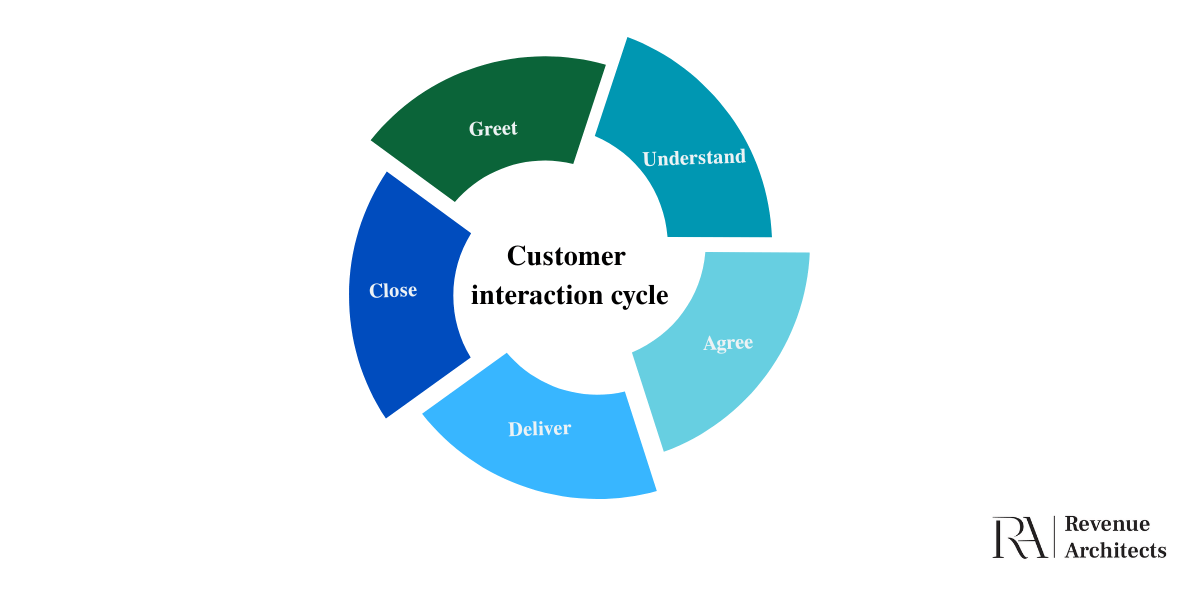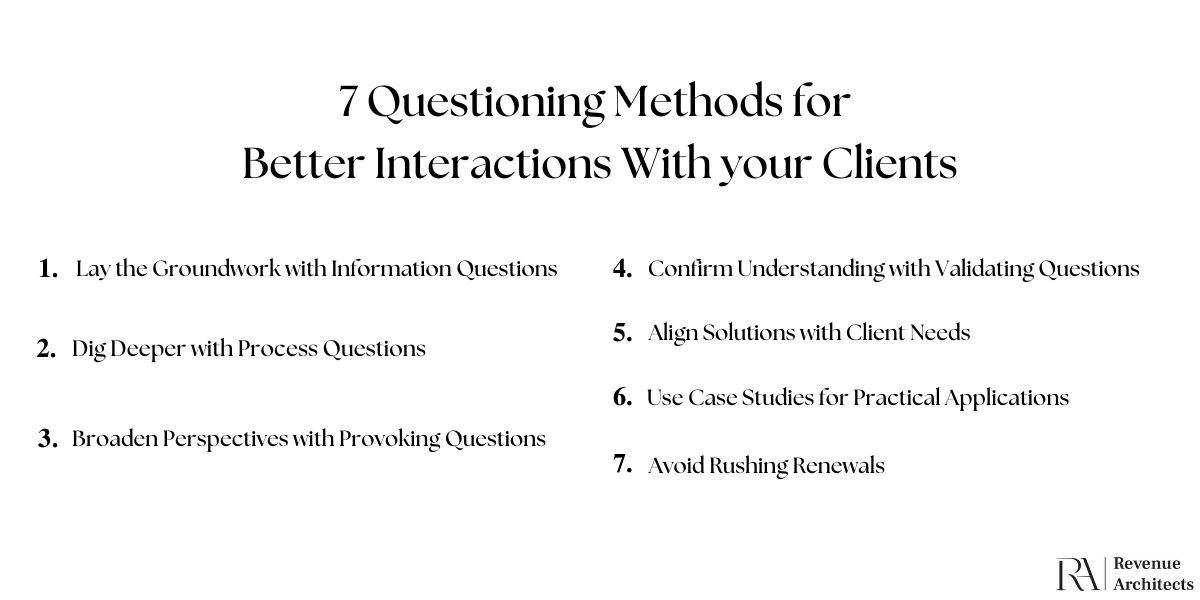Mastering questioning techniques to improve client interactions is not just a skill but a crucial tool that can significantly influence your company’s success. Effective questioning is the key to unlocking information and positioning your product or service as the ultimate solution to your client’s problems.
To understand how to incorporate questioning methods into your business cycle, it’s important to recognize that this process involves approximately five stages. In this article, we will help you understand what these stages are and which questions you can use to improve your interactions with interested parties.
There are five steps in interaction with clients that form a solid interaction cycle.
Keep in mind the five essential steps for effectively interacting with clients to establish a strong interaction cycle:

To better remember these steps, envision the process of entering a boutique with the intention of purchasing the perfect suit.
Now, let’s dive deeper into the details of questioning, which can help you create a perfect interaction cycle if you are trying to sell your services or product.
We know that it is much easier to follow a certain cycle of interaction when you have example questions in front of you. With the following questions, it will be much easier for you and your team to stay on track, and you can also use this to train new members of the team. In the end, you have a short template that you can follow each time with these examples in mind.
Information questions are the cornerstone of any discovery phase, aimed at comprehensively understanding your client’s situation. These questions help you gather essential details about the company’s operations, challenges, and expectations.
Example: “What are your organization’s primary challenges in the current market?”
These questions provide a broad overview, enabling you to understand what works well and what doesn’t, which is crucial for tailoring your solutions to the client’s needs. By delving into the intricacies of their business environment, you can discern the nuances that influence their decision-making process. For instance, if a client reveals they struggle with integrating new technology, this insight allows you to tailor your pitch to highlight how your solution seamlessly integrates with their existing systems, thereby addressing a pivotal concern.
Process questions focus on the “how” of your client’s operations, revealing the methodologies and procedures behind their daily activities. These questions uncover technical problems and root causes your product or service can address.
Example: “How does your team handle project management and execution?”
By understanding the client’s processes, you can identify inefficiencies and position your solution as a critical improvement to their existing workflows. This deeper dive into their operations uncovers the pain points that might not be immediately visible but are essential to their overall efficiency. For example, if a client describes a cumbersome approval process, you can present your solution’s streamlined approval features, demonstrating an immediate value proposition that addresses their needs.
Provoking questions are designed to challenge your clients’ thinking and encourage them to consider broader implications and risks they may have overlooked. They help uncover hidden issues and potential impacts.
Example: “Have you considered the long-term impact of high employee turnover on your strategic goals?”
Such questions push the client to think beyond immediate issues, facilitating a deeper engagement and understanding of the broader picture. By prompting clients to evaluate the long-term consequences of their current challenges, you help them see the bigger picture. For instance, a client-focused solely on short-term sales targets might need to recognize the cumulative impact of high staff turnover on long-term customer relationships. Your strategic and insightful question can open their eyes to these broader ramifications, positioning you as a strategic thinker.
Validating questions aim to confirm your understanding of the client’s statements and ensure alignment between both parties. These closed-ended questions seek a simple yes or no answer, eliminating ambiguity.
Example: “If I understand correctly, you’re facing significant challenges with your supply chain logistics, which are affecting delivery times and customer satisfaction.”
These questions act as a compass, anchoring the conversation with specific facts and building a bridge of trust and understanding between you and the client. By confirming your understanding, you demonstrate active listening and attention to detail, which in turn builds credibility and rapport with the client. For example, validating their concerns about supply chain issues shows that you’re attuned to their specific challenges and committed to addressing them accurately.
Transitioning from the discovery phase to presenting your solution requires aligning your offering with the specific pain points identified through questioning. Tailor your presentation to address each concern directly, demonstrating a deep understanding of the client’s needs.
Example: Highlight how a specific feature of your product can generate a higher ROI or provide critical visibility.
This tailored approach reinforces the relevance and utility of your solution, making it more compelling to the client. By aligning your solutions with the identified pain points, you show that you’re not just selling a product but offering a tailored solution that meets their unique needs. For instance, if a client’s primary concern is reducing operational costs, you can focus on how your product’s efficiency improvements lead to significant cost savings.
Applying questioning techniques to real-life scenarios, such as low, close rates, can illustrate their effectiveness. Information questions may reveal issues with deal strategies, while process questions uncover inefficiencies. Provoking questions challenges the client to consider long-term impacts, and validating questions confirms their acknowledgement of these problems.
Example: “A tech startup we worked with had a 15% close rate, much lower than their competitors. After conducting information and process questions, we discovered they had overly technical demos and inconsistent follow-ups. We revamped their demo to highlight key benefits in just 15 minutes and implemented a CRM system for structured follow-ups. Within six months, their close rate increased to 35%, and their sales team reported higher engagement from prospects. This streamlined approach led to a significant boost in their revenue.”
Share a case study from a previous client with a similar situation to reinforce your proposal.
When wrapping up, avoid jumping straight into renewal pitches. Instead, ensure that your solution aligns with the client’s pain points. Validating questions will confirm that all their concerns have been addressed, securing their confidence in your proposed path forward.
Example: “Have we covered all the key issues you’ve been facing, and do you feel confident in the proposed solutions?”
This step ensures no lingering doubts and reinforces the client’s commitment to your solution. By validating their confidence in your proposed solutions, you respect their decision-making process and strengthen their trust in your partnership. For instance, asking for their confirmation that all issues have been addressed helps to solidify their belief in the value of your solution, leading to a more natural and assured renewal process.

Each client interaction presents an opportunity to demonstrate your expertise and build trust. Therefore, it’s crucial to refine and apply questioning techniques to enhance your effectiveness continuously. By consistently utilising these skills, you can elevate client engagements and achieve significant success in your business.
This profound understanding allows you to position your product or service as the optimal solution, leading to successful outcomes and nurturing enduring client relationships. If you need a more detailed approach for your niche or you have additional questions, don’t hesitate to contact us. We can help you and your sales team achieve more with personalized coaching sessions.
Growthnetix OÜ
Harju maakond Kesklinna
linnaosa, Ahtri tn 12, 10151
Tallinn, Estonia
VAT number: EE102550717